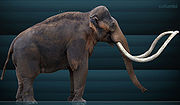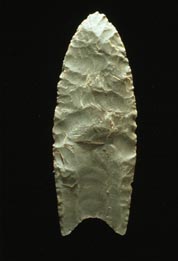
Dent Site
Encyclopedia


Clovis culture
The Clovis culture is a prehistoric Paleo-Indian culture that first appears 11,500 RCYBP , at the end of the last glacial period, characterized by the manufacture of "Clovis points" and distinctive bone and ivory tools...
(about 11,000 years before present) site located in Weld County, Colorado
Weld County, Colorado
As of the census of 2000, there were 180,936 people, 63,247 households, and 45,221 families residing in the county. The population density was 45 people per square mile . There were 66,194 housing units at an average density of 17 per square mile...
, near Milliken, Colorado
Milliken, Colorado
Milliken is a Statutory Town in Weld County, Colorado, United States. The population was 2,888 at the 2000 census.-Geography:Milliken is located at ....
. It was the first site to provide evidence that man and mammoth co-existed in the Americas.
The site is located on an alluvial fan
Alluvial fan
An alluvial fan is a fan-shaped deposit formed where a fast flowing stream flattens, slows, and spreads typically at the exit of a canyon onto a flatter plain. A convergence of neighboring alluvial fans into a single apron of deposits against a slope is called a bajada, or compound alluvial...
alongside the South Platte River
South Platte River
The South Platte River is one of the two principal tributaries of the Platte River and itself a major river of the American Midwest and the American Southwest/Mountain West, located in the U.S. states of Colorado and Nebraska...
.
Discovery
Following a period of heavy rainfall and flooding in 1932, Frank Garner, Union Pacific RailroadUnion Pacific Railroad
The Union Pacific Railroad , headquartered in Omaha, Nebraska, is the largest railroad network in the United States. James R. Young is president, CEO and Chairman....
employee, discovered large animal bones that were exposed near the Dent railroad station.
Clovis culture
The Clovis cultureClovis culture
The Clovis culture is a prehistoric Paleo-Indian culture that first appears 11,500 RCYBP , at the end of the last glacial period, characterized by the manufacture of "Clovis points" and distinctive bone and ivory tools...
(about 11,950 - 10,950 years before present) is the first culture in the Americas to use projectile point
Projectile point
In archaeological terms, a projectile point is an object that was hafted to a projectile, such as a spear, dart, or arrow, or perhaps used as a knife....
s in hunting. Previous to that, indigenous people used a tool-kit like that used in Asia
Asia
Asia is the world's largest and most populous continent, located primarily in the eastern and northern hemispheres. It covers 8.7% of the Earth's total surface area and with approximately 3.879 billion people, it hosts 60% of the world's current human population...
, which included large axe
Axe
The axe, or ax, is an implement that has been used for millennia to shape, split and cut wood; to harvest timber; as a weapon; and as a ceremonial or heraldic symbol...
cutting tools, scrapers
Scraper (archaeology)
In archaeology, scrapers are unifacial tools that were used either for hideworking or woodworking purposes. Whereas this term is often used for any unifacially flaked stone tool that defies classification, most lithic analysts maintain that the only true scrapers are defined on the base of...
, blades and flake tool
Flake tool
In archaeology a flake tool is a type of stone tool created by striking a flake from a prepared stone core.The flake could be sharpened by retouch to create scrapers or burins.-References:...
s. The Clovis point
Clovis point
Clovis points are the characteristically-fluted projectile points associated with the North American Clovis culture. They date to the Paleoindian period around 13,500 years ago. Clovis fluted points are named after the city of Clovis, New Mexico, where examples were first found in 1929.At the right...
was the first use of large, symmetrical and fluted projectile point
Projectile point
In archaeological terms, a projectile point is an object that was hafted to a projectile, such as a spear, dart, or arrow, or perhaps used as a knife....
s.
Mammoth bones
MammothMammoth
A mammoth is any species of the extinct genus Mammuthus. These proboscideans are members of Elephantidae, the family of elephants and mammoths, and close relatives of modern elephants. They were often equipped with long curved tusks and, in northern species, a covering of long hair...
bones and what were later called Clovis points were found at the Dent Site in 1932. The site was notable for both the presence of the projectile points larger than the known Folsom point
Folsom point
Folsom points are a distinct form of chipped stone projectile points associated with the Folsom Tradition of North America. The style of toolmaking was named after Folsom, New Mexico where the first sample was found within the bone structure of a bison in 1927....
s and the first evidence that man and mammoth co-existed in the Americas. The mammoth killed were not part of a family group, as originally hypothesized, and were not related to other mammoth killed at Clovis sites, such as Blackwater, New Mexico
Blackwater, New Mexico
Blackwater, New Mexico is the designation of a HVDC back-to-back facility for the power exchange between the asynchronous power grids of Texas and New Mexico. It was built by Brown Boveri in 1985 and can transfer a power up to 200 megawatts. The used voltage is 57 kV....
and Miami, Texas
Miami, Texas
Miami is a city in Roberts County, Texas, United States. It is part of the Pampa, Texas Micropolitan Statistical Area. The population was 588 at the 2000 census...
.
Excavations
| Year | Name | Organization | Period and artifacts | Comments |
|---|---|---|---|---|
| 1932 | Father Conrad Bilgery | Regis University Regis University Regis University is a private, co-educational Roman Catholic, Jesuit university in the United States. Founded by the Society of Jesus in 1877, it is one of 28 member institutions of the Association of Jesuit Colleges and Universities... |
Columbian mammoth (Mammuthus columbi) bones and projectile points later identified as Clovis points. | Father Conrad Bilgery at Regis College Regis University Regis University is a private, co-educational Roman Catholic, Jesuit university in the United States. Founded by the Society of Jesus in 1877, it is one of 28 member institutions of the Association of Jesuit Colleges and Universities... was notified following the discovery who conducted an initial excavation of the site. |
| 1933 | Jesse Dade (J.D.) Figgins | Denver Museum of Natural History Denver Museum of Nature and Science The Denver Museum of Nature & Science is a municipal natural history and science museum in Denver, Colorado. It is a resource for informal science education in the Rocky Mountain region. A variety of exhibitions, programs, and activities help museum visitors learn about the natural history of... |
At least 12 mammoth, mostly young or female. Figgins believed rocks 12 inches (30.5 cm) were brought in to assist the kill. | Figgins was considered the "Early Man expert" due to his work at the Folsom Site Folsom Site Folsom Site , in Folsom, New Mexico, is the archaeological site that is the type site for the Folsom tradition, a Paleo-Indian cultural sequence dating to between 9000 BC and 8000 BC... in New Mexico. |
| 1973 | Joe Ben Wheat Joe Ben Wheat Dr. Joe Ben Wheat was an archaeologist, curator, teacher, and author known for his expertise on blanket weavings and textiles of the Navajo and other Indians in Arizona, New Mexico, and Colorado. His research focused on Mogollon, Anasazi, Great Plains Paleo-Indian, and African Paleolithic... , Marie Wormington, Frank Frazier, Vance Haynes Vance Haynes Caleb Vance Haynes Jr. , known as Vance Haynes or C. Vance Haynes Jr., is an archaeologist, geologist and author who specializes in the archaeology of the American Southwest... |
University of Colorado University of Colorado The University of Colorado system is a system of public universities in Colorado consisting of three universities in four campuses: University of Colorado Boulder, University of Colorado Colorado Springs, and University of Colorado Denver in downtown Denver and at the Anschutz Medical Campus in... |
Total of 15 mammoth. | Radiocarbon dating Radiocarbon dating Radiocarbon dating is a radiometric dating method that uses the naturally occurring radioisotope carbon-14 to estimate the age of carbon-bearing materials up to about 58,000 to 62,000 years. Raw, i.e. uncalibrated, radiocarbon ages are usually reported in radiocarbon years "Before Present" ,... of 11,200 +/- 500 years before present. |
| 1987 | Robert Brunswig, Jr. | University of Northern Colorado University of Northern Colorado -Organization:The University of Northern Colorado offers 100 undergraduate programs and more than 100 graduate programs. The university has a satellite campus in Denver, Colorado... |
Total of 15 mammoth, 10 young and 5 adults (22-43), with evidence of butchering. | Radiocarbon dating was performed again, with dates 10,590 +/- 500 years before present and 10,950 +/- 480 years before present, at the low end of the estimated range from 1973. The killings were estimated to have been committed during the fall. Plants of the late Pleistocene Pleistocene The Pleistocene is the epoch from 2,588,000 to 11,700 years BP that spans the world's recent period of repeated glaciations. The name pleistocene is derived from the Greek and .... period were found in mammoth teeth tarter: grass, prickly pear Opuntia Opuntia, also known as nopales or paddle cactus , is a genus in the cactus family, Cactaceae.Currently, only prickly pears are included in this genus of about 200 species distributed throughout most of the Americas. Chollas are now separated into the genus Cylindropuntia, which some still consider... , bark and river River A river is a natural watercourse, usually freshwater, flowing towards an ocean, a lake, a sea, or another river. In a few cases, a river simply flows into the ground or dries up completely before reaching another body of water. Small rivers may also be called by several other names, including... ine plants. |
Further reading
- Brunswig, Robert H; Pitblado, Bonnie L. (editors). (2007). Frontiers in Colorado Paleoindian Archaeology, From the Dent Site to the Rocky Mountains. University of Colorado Press. ISBN 978-0-87081-890-5.
- Haynes, Gary. (1993). Mammoths, mastodonts, and elephants: biology, behavior, and the fossil record. Cambridge University Press. ISBN 0-521-45691-6.

